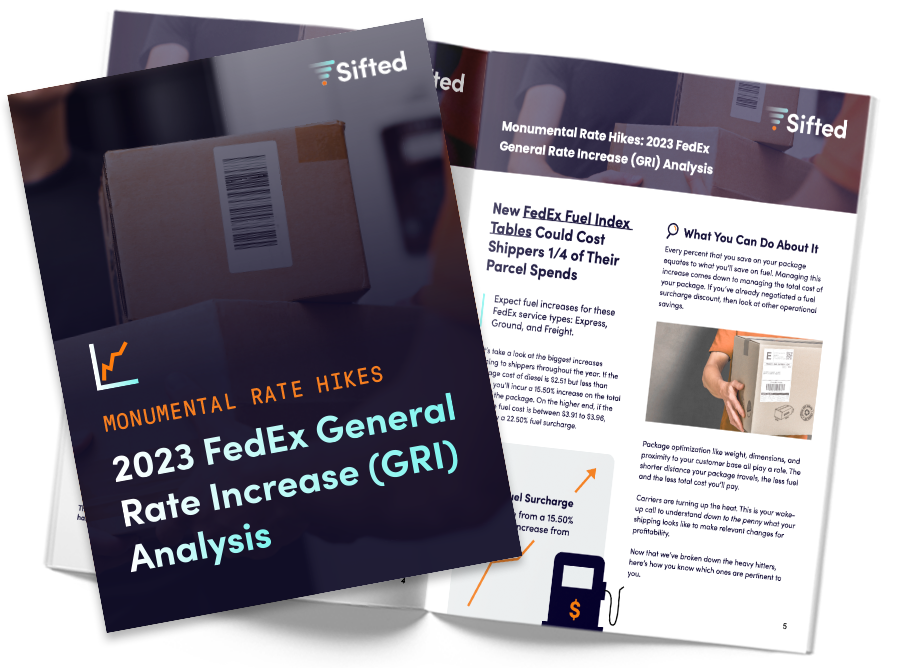What are UPS Supply Chain Solutions?
UPS Supply Chain Solutions™ (UPS-SCS) is part of United Parcel Service of America, Inc. (UPS), offering warehousing and distribution, customs clearance, global freight forwarding, and other supply chain services.
Its sophisticated supply network helps ensure that shipments and cargo move efficiently and quickly around the world. UPS Supply Chain Solutions provides the technology and resources to help businesses streamline their logistics operations.
UPS-SCS uses AI to improve its package sorting operations and identify the best ways to load packages onto trucks. In addition, UPS is developing drones to deliver packages and strengthen its supply chain network.
In this article, we’ll discuss various supply chain management services offered by UPS, including transportation management, supplier management, insurance services, and customs brokerage. We’ll also point out alternative supply chain solutions that help businesses improve logistics performance.
Examples of UPS Supply Chain Solutions™
Here’s what you need to know about UPS’s different supply chain solutions and how they fit into domestic and international shipping processes.
Transportation Management
Few supply chain processes impact the success of your business as much as transportation. UPS transportation management provides the technology, transportation purchasing power, and visibility you need to ensure a smooth flow of shipments to and from your facility to their destinations on time.
UPS enables its customers to plan and optimize their transportation activities to identify the best routes and modes. This helps businesses drive down their shipping spending and improve the reliability of their logistics services.
Its cloud-based TMS platform integrates with your existing warehouse management systems to streamline your warehousing and order fulfillment needs. Its powerful TMS also helps you find the right logistics partners to meet your capacity requirements, including truckload, less-than-truckload (LTL), air freight, intermodal, and ocean freight transportation.
In addition, UPS allows you to track customer and transportation data to gain visibility in your supply chain operations and meet delivery windows.
Supplier Management
Effectively managing your suppliers is essential to fulfilling your operational demands. And if you work with local and international suppliers, you already understand the complexity of navigating tight deadlines, procurement problems, and communication barriers.
UPS’s supplier management helps deal with the increasing complexity of supply chains by unifying data streams from vendors, carriers, UPS, and customers into a centralized dashboard. By streamlining important information and data, you can better understand your business needs and identify opportunities for improvement.
Moreover, UPS supply chain management service evaluates an international supplier’s compliance on your behalf based on your set parameters to ensure your goods match your purchase orders. You can track events and milestones to identify at-risk shipments and potential delays.
It also offers a complete global logistics solution that handles everything from consolidation, warehousing, customs brokerage, and end-to-end product management. In addition, the UPS forwarding hub provides a customer portal that lets you compare quotes, book and track shipments, and gain complete visibility into your shipping operations.
Insurance Services
As more sellers move their businesses to eCommerce selling, the need for a shipping insurance solution is becoming more prevalent. Cargo and parcel insurance covers your shipments from loss, damage, or delays during transportation. This coverage reimburses the invoice value of your goods if a covered event occurs while the shipment is in transit.
UPS InsureShield™ provides complete coverage (reimbursement of the total value of goods, plus transportation fees). It offers tailor-made coverage options for warehousing and transportation so you can decide what areas of the supply chain you want to cover and when. In addition, the UPS Trade Credit Protection service covers your costs if a customer refuses to pay an invoice.
Customs Brokerage
Customs brokers play an important role in international trade and international shipping. They provide customs clearance services to facilitate importing and exporting goods across international borders.
UPS customs brokerage services give you access to customs experts that assist you with global regulatory compliance and preparing the required documents for export shipments. They help you calculate duties, taxes, and other customs fees, coordinate customs brokerage outside North America, and offer complete visibility into shipments and clearance status.
You can utilize an EDI (Electronic Data Interchange) software to reduce the time and cost required for reproducing and sending information, enabling you to easily track goods, import them, and prepare paperwork.
Alternative Solutions to Strengthen Your Supply Chain
Now that we have discussed the supply chain services offered by UPS, let’s evaluate alternatives to these solutions, starting with artificial intelligence.
Logistics Intelligence
When you integrate artificial intelligence in supply chain management, you can automate many repetitive tasks and allow your employees to focus on more valuable business activities.
Logistics Intelligence uses AI prediction technology to predict future customer demand and minimize the risk of stock shortage during peak seasons. In addition, supply chain AI emulates human knowledge and performance to automatically improve service levels, identify risks, and improve performance.
For example, logistics intelligence software can help speed up order delivery by identifying faster delivery routes. IoT sensors monitor machines and equipment that automatically generate replacement parts, reducing potential downtimes.
Machine learning and AI make it possible to continuously learn from supply chain data and make better shipping and inventory management decisions. Similarly, AI robots communicate with WMS and humans and seamlessly perform order picking, loading, and unloading tasks.
Do you need a strong logistics strategy? Sifted Logistics Intelligence can help simplify logistics for your business.
Network Distribution Optimization
Network distribution optimization helps businesses re-engineer existing distribution networks to mitigate supply chain risks and reduce costs. Supply chain managers network develop distribution models based on demand forecasts and identify partners at different locations. Moreover, managers can:
- Find the best possible locations for warehouses.
- Identify cost-saving opportunities in terms of inbound and outbound costs, intercompany transport between the various production sites, inventory deployment costs, labor costs, etc.
- Evaluate how changing market conditions can affect your profitability
- Find ways to improve customer service standards.
- Run sensitivity analysis to evaluate impacts of change in freight transport and location
- Develop simulation models to evaluate the costs of shipping delays and package size.
This study reveals valuable insights about a company’s distribution strategy and identifies ways to improve the speed and reliability of its distribution networks.
Sifted enables you to run “what if” scenarios to evaluate what it looks like to open a distribution center and how it can help you reduce transit times and zone-based fees—before you even lift a finger.
Package Modeling
Businesses use package modeling to minimize the cubic size needed to ship packages. This reduces the costs of packaging materials, boosts productivity, and increases picking efficiency.
eCommerce sellers understand that finding the right box for an item’s size, shape, and weight is difficult. Even smaller items like table lamps can be tricky since they come in different shapes and sizes. Is it best to pack the whole lamp in the same box or pack its parts separately? Should both boxes be the same size or different? What about non-conveyable or ugly freight?
Package modeling reduces shipping costs by finding the optimal way to pack every shipment. It uses simulation to determine the right kind, size, and quantities of packing material to lower costs throughout the supply chain.
Shipping carriers like FedEx and UPS charge additional handling and oversize/dimensional surcharges on packages that exceed their permitted size and weight.
Sifted’s package modeling helps shippers optimize their packaging to reduce unnecessary costs and packaging space. It simulates changes based on size, weight, and shipping mode to reduce overpacking and avoid carrier surcharges.
GRI and Peak Season Analysis
A General Rate Increase (GRI) is an additional charge imposed on regular shipping fees and surcharges by major shipping companies. UPS and FedEx have increased their fees by an average of 6.9% for 2023 across all their services, up from 5.9% in 2022.

Monumental Rate Hikes
Peak season surcharge is another rate adjustment applied to shipping rates and surcharges when the demand is high such as during the holiday season. Carriers increase their fees to match the operational costs of increased shipment volume.
Most shippers expect their shipping costs to rise by about 5% every year due to GRI and peak season surcharges. These rate changes inflate shippers’ total cost of shipping.
GRI and peak season analysis can help you better position your business for these rate hikes. This includes knowing the exact size, weight, and volume of your packages and shipment destinations (i.e., distance from distribution centers and residential vs. commercial addresses). This study can help you determine how significantly upcoming shipping fees and surcharges will impact your bottom line.
You can also use this information to optimize your shipping strategy, such as modifying package weight and dimensions based on carrier requirements, consolidating shipments, skipping shipping zones, etc.
Shipping companies use your shipping profile data when working out shipping contracts. You can use the shipping information available to you to negotiate favorable rates and build a better budget for rate fluctuations.
Sifted’s logistics management solutions help shippers see the data the carriers are seeing and make better decisions on positioning their shipments. It helps them understand their shipping profile inside and out and forecast what’s next for their business.
See What’s Next for Your Shipping Business with Sifted
UPS Supply Chain Solutions™ is a global leader in supply chain management, helping businesses deliver shipments more efficiently and safely. There are other innovative supply chain solutions, such as logistics intelligence and automated mobile robots (AMRs), that increase the productivity and flexibility of logistics operations.
Sifted Logistics Intelligence tools give you complete visibility into your shipping data in one place. It helps you understand demand patterns, make accurate forecasts, and quickly analyze and visualize information from multiple sources to make better supply chain decisions.
Reduce costs using AI-powered demand forecasting. Get a free demo from Sifted!











